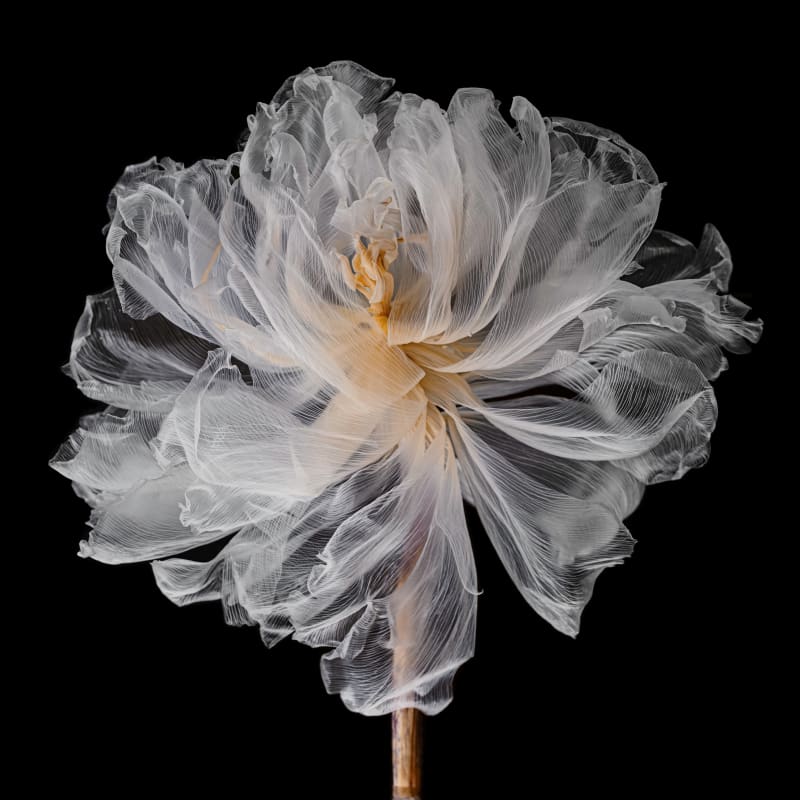Kathrin Linkersdorff (born 1966 Berlin) trained and worked as an architect before studying photography at the Schule für Fotografie am Schiffsbauerdam in Berlin with Robert Lyons, 2006-2007.
Linkersdorff is known for her botanical photography, particularly of tulips, influenced by the Japanese perspective of appreciating nature. Embracing the philosophy of Wabi-Sabi, finding beauty in impermanence and imperfection, her work captures flowers at distinct moments, celebrating the cycle of life and the transient beauty of passing time.
In the series, Wabi Sabi 2013-18, the images picture a single flower against a black background. 'Each flower was valuable to me, for each one was different ... I wanted to learn how to control and influence the process of wilting and drying'. (Kathrin Linkersdorff). A single flower's fleetingly short time on earth, the cycle and ethereality of its petals, can be seen to provide a reflection on both life’s vitality and fragility. Linkersdorff goes further by pushing these boundaries, framing the flower for 'eternity' in its most fragile form as it approaches disintegration.
Fairies, an ongoing series at the intersection of photography and botany, is the result of years of experimentation and testing: capturing fading moments of transience with the lightest possible touch. Research and the practice of biological methodology has turned her studio into a laboratory, where tulips are carefully dried over long periods of time. Colours are extracted from the flowers and reconcentrated into coloured liquids based on the water-soluble plant pigments, anthocyanins. These extracted colours are carefully reintroduced to the faded plant tissues which are given space to again unfurl. The interaction between colour and form becomes a poetic dance that also reveals the hidden alchemy present in all living matter.
‘Is it possible to look at this photographer’s Fairies without a rain of associations falling upon them? What fascinates me is the undulating sense of a slow-motion ballet. I am reminded of those films of astonishing deep-sea creatures, or even jellyfish. In 1920 Doyle wrote of the Cottingley Fairies, `The recognition of their existence will jolt the material 20th Century mind out of its heavy ruts in the mud, and will make it admit that there is a glamour and a mystery to life’. Kathrin Linkersdorff’s Fairies, appearing one hundred years later, might well have satisfied Doyle’s yearning.' (William Ewing)
In her Microverse series, created in collaboration with microbiologist Prof. Dr. Regine Hengge, Linkersdorff continues her exploration of nature's cycles by visualising the dynamic interplay of growth and decay. Discoloured plants and fruits serve as a substrate for bacterial colonies, which form strikingly colourful and morphologically complex patterns as they metabolize the organic material. Through this process, Linkersdorff captures the essential circularity of life, turning decay into something unexpectedly beautiful. The Microverse series resonates with her prevailing theme of embracing the beauty in transience, and highlights the intricate processes that drive nature’s transformation.
To celebrate the acquisiton of her work, Philadelphia Art Museum included it in a presentation of floral works in their collection in 2023. The major exhibition, Kathrin Linkersdorff - Works, took place at the Deichtor Hallen, Internationale Kunst und Fotografie, Hamburg, 2023-24, and her new research project making use of bacteria was exhibited here for the first time. The book Kathrin Linkersdorff: Works was published in 2024 by Hartmann Books to coincide with the exhibition. Microverse, an exhibition of her work from 2013–2025, was on view until 8 June 2025 at Haus am Kleistpark, Berlin.
The solo show Kathrin Linkersdorff: Microverse, including both her Microverse and Fairies series, is exhibting at Stadthaus Ulm, Germany, from 22 June to 21 September 202.
